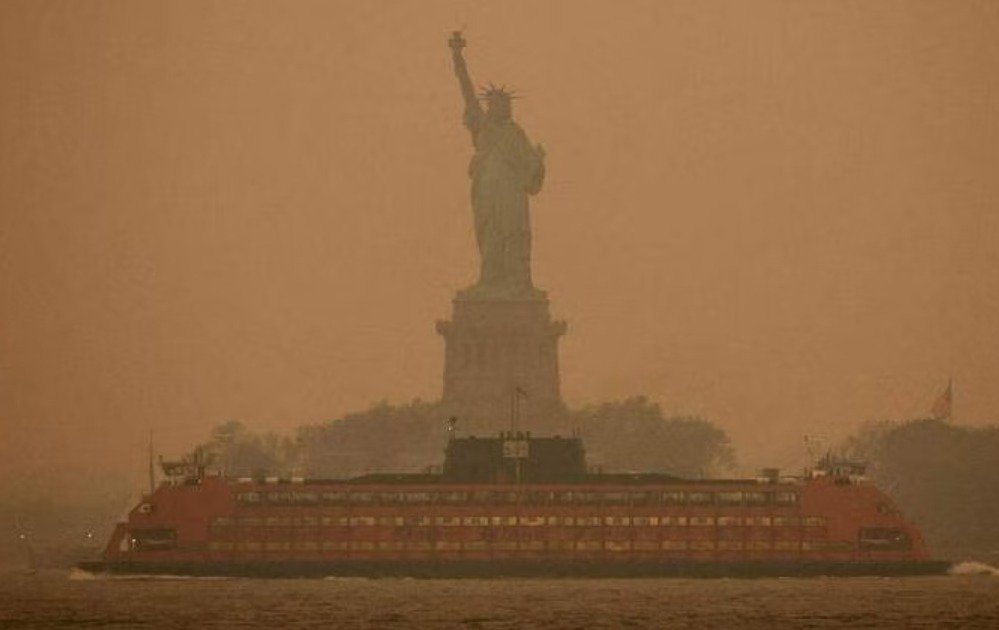A dense smoky haze covered a wide area of the northern United States on Tuesday, originating from Canada where numerous wildfires were raging. This led to air quality alerts being issued from Minnesota to Massachusetts.Parts of Ottawa and Toronto in Ontario were shrouded in a layer of haze, and Canadian officials cautioned residents about the poor air quality as the smoke spread over New York state and Vermont.
The entire New York City was under an air quality alert on Tuesday, as the Manhattan skyline became obscured by the hazy skies. More than 400 active wildfires were reported in Canada, exacerbating an already active wildfire season expected to worsen.
Of these fires, over 200 were burning out of control. Quebec in eastern Canada was particularly affected, with over 150 active blazes in the region. Local officials in Quebec urged residents to close their windows and doors.Videos and images depicted fires stretching for kilometers and emitting dark plumes of smoke into the sky. Prime Minister Justin Trudeau stated during a news conference on Monday that he was in contact with officials across Canada regarding the fires and acknowledged the fear and hardship experienced by many.
By Monday, approximately 26,000 people had been evacuated from their homes due to wildfires, according to Bill Blair, Canada’s Minister of Public Safety. Blair described the severity of the fires as some of the most extreme ever witnessed in Canada.Many Canadians had only a few hours to pack their belongings before fleeing their homes. Trudeau emphasized the emotional impact of losing homes, as they represent cherished memories and a sense of belonging.
The smoke from the wildfires drifted southward across the border on Tuesday, resulting in hazy skies and air quality alerts issued by the US National Weather Service for parts of the upper Great Lakes and the northeast.
Large areas of Minnesota were under air quality alerts as smoke from Quebec’s wildfires, along with smoke from Lake Superior, was blown across the state due to light winds.
The National Weather Service cautioned that individuals with lung disease, heart disease, children, and older adults, who are more sensitive to poor air quality, should restrict certain outdoor activities.
Air quality alerts were also in effect for New York City and several counties in upstate New York until midnight. Mayor Eric Adams advised New Yorkers with respiratory issues to limit their time outdoors to essential activities.
Similar alerts were issued for parts of Connecticut, Massachusetts, and Vermont. Toronto and New York City briefly ranked among the top 10 major cities with the poorest air quality, according to IQAir, a technology company tracking air quality worldwide.
Historically, these cities do not rank among the worst 3,000 cities for air quality. The New York State Department of Environmental Conservation anticipated continued poor air quality through Wednesday for much of upstate New York and the New York City region.
Satellite images of North America showed thick brown smoke drifting south from the fires, particularly over parts of Quebec, Ontario, and New York. The hazy conditions could extend as far south as the Carolinas.
Apart from affecting air quality, the smoke from the wildfires could create vivid reddish sunsets, similar to those observed last month when smoke from Canadian wildfires reached New York. Meteorologists suggested that such sunsets and poor air quality levels could persist throughout the summer if wildfires in Canada continue.
Hundreds of soldiers were deployed across Canada to assist with firefighting efforts, and other government agencies were prepared to respond if critical infrastructure was affected by the wildfires.
Trudeau stated on Monday that forecasts indicated an especially severe wildfire season throughout the summer. So far this year, Canada has experienced over 2,200 wildfires, according to the country’s fire agency.


